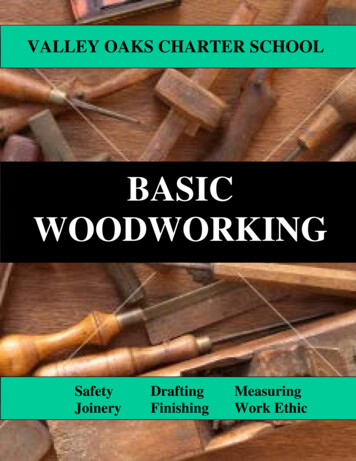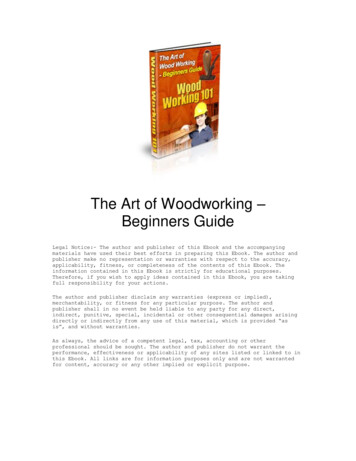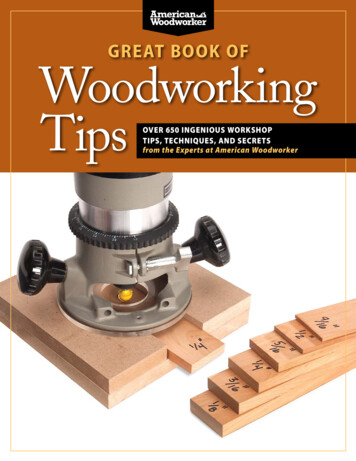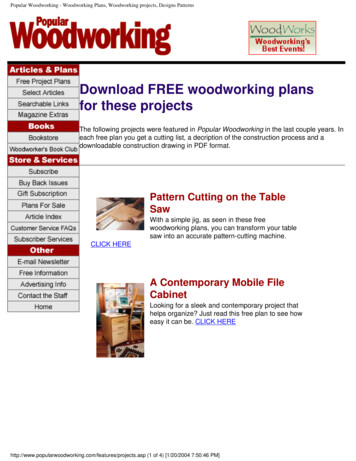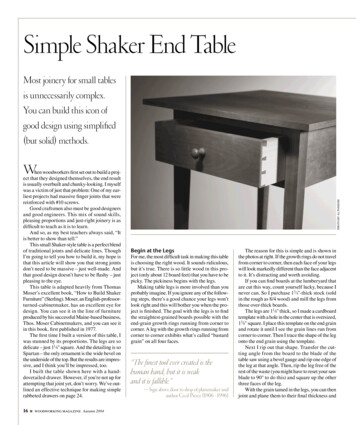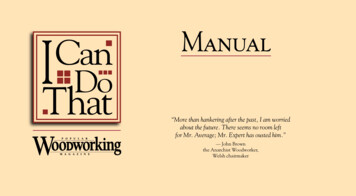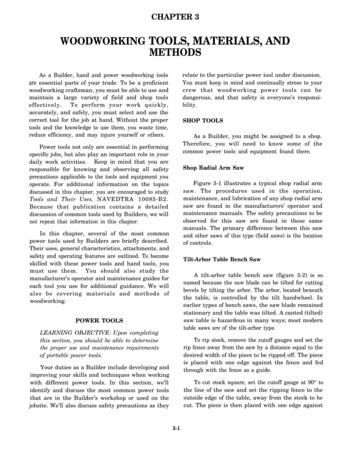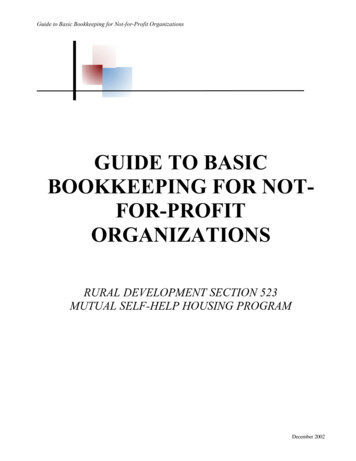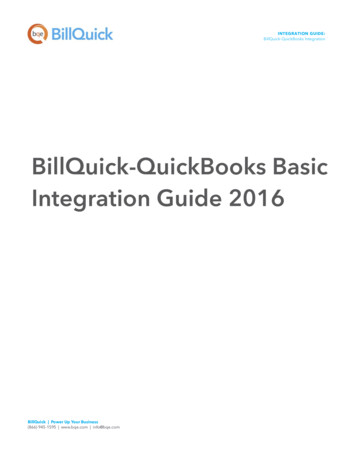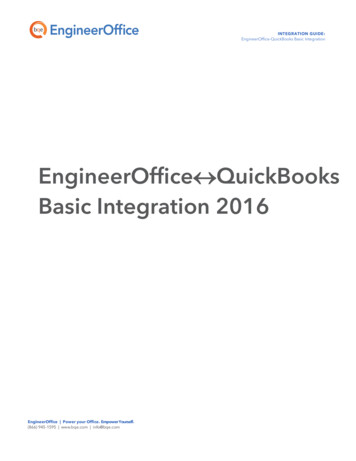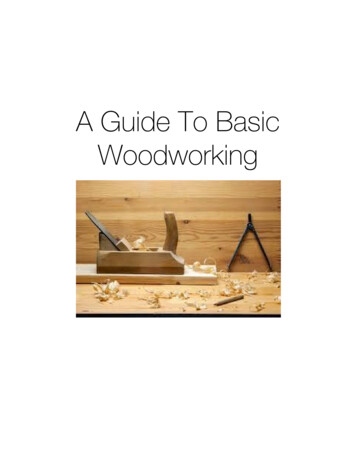
Transcription
A Guide To BasicWoodworking
ContentsIntroduction . 4Timber . 5Solid Timber . 5Particle Board . 7Plywood . 9MDF . 11Veneer . 13Joints . 15How to Make Butt Joints . 16Mitre Joint . 19How to Make Mitre Joints . 20Rebate Joint. 21Housing Joint . 23Halving Joint . 26Dowel Joint . 28How to Make Dowel Joints . 29Biscuit Joint . 31How to Make Dovetail Joints . 34Mortise and Tenon Joint . 39Bridle Joint. 48How to Make Bridle Joints . 49
Tongue and Groove Joint . 54Finishes. 57Stains . 57Oils . 58Wax. 60Acrylic . 61Polyurethane . 62Adhesives . 64PVA . 64Epoxy . 65Polyurethane . 66Contact Adhesive . 68Facts and Tips . 69Hardwood . 69Softwood . 70Wood Layers . 72Woodwork Tips . 75
IntroductionSo are you interested in wood or have a passion for working with it?Well then you have come to the right place because this is whereyou can get all of your wood info.Not only will you find plenty of information on things such astimber, joints, finishes and adhesives, but you'll also find info oncomponents, tools and I'll even throw in some handy facts and quicktips just to give you that little bit of extra help.The info you will find on this website is about general areas relatedwith wood which includes things such as some carpentry, cabinetmaking and furniture.So if you like working with wood then you should be able to findplenty of information to help you out before you start your nextwood project.
TimberSolid TimberSolid timber is rapidly becoming scarce and expensive due to loggingand the long periods of time it takes for most trees to grow. There aremany different timbers on the market that range in price,characteristics and strength.The two categories that timber can be put into are hardwoods andsoftwoods and the two can be defined by their differences in thewoods microstructure which determines its density and strength.This timber is an excellent choice for any sort of woodwork but if youwant a good quality timber with minimum flaws, be prepared to pay abit extra due to the reasons above. Cheaper timbers such as pine canbe good but don't compare in aesthetics and quality to dearer timbers.In my opinion solid natural timber is the best type of timber forcabinet making and furniture use because it has the best features andcharacteristics. Manufactured boards are also good but nothingcompares to solid natural timbers.
Advantages: It is the most aesthetically pleasing type of timberThere are a vast amount of types for example Tasmanian oak,pine, JaraIt is suitable for all woodwork jointsIts long lastingThere are a range of colours, textures and grains availableTakes adhesives and finishes wellDisadvantages: Can be expensiveCan be difficult to find the timber you are afterHas natural defects such as knotsCan warp, shrink, twist or swell
Particle BoardParticle board is a manufactured board that is often used in furniturebecause it can be made cheaply and is more affordable than solidtimber but has a similar look.It is mostly found in furniture that require large pieces such as tabletops, desks and TV cabinets, this saves people from having to bond twopieces of timber together to achieve the same size.This type of manufactured board is made from wood chips which areglued together and then compressed under heat in a large board shape,it is then dried and cut into various sizes to be sold.These boards can either be bought bare or it can be covered with thinsheets of veneer or a plastic laminate, these two materials give theboard a solid timber look and feel while costing marginally less.Particle board is a good alternate option when buying furniture to abudget because it gives the impression of solid timber and it usuallylasts for long periods of time if looked after and taken care of well, likeall solid timber.
Advantages: Cost effectiveIt is available in large sizesVeneer or plastic laminate can be applied to make it look morelike solid timberIt doesn't have natural defects and It doesn't swellRenewableDisadvantages: Still doesn't quite match the quality of solid timberCan be prone to chip or flakeIt isn't available in very thick sizesIt isn't suitable for many joints
PlywoodPlywood is another manufactured board that it is made from layers ofsolid timber veneer that are usually about 3 millimetres thick. Becauseit is made in layers it is incredibly strong but also light in weight.The interior layers of these boards are usually made from aninexpensive wood while the outer veneer layers are made from moreexpensive timber to give the board a nice wood grain appearance.This type of board is manufactured from layers of veneer that areglued together and compressed under heat, they are then cut intoappropriate sizes. With each new layer of veneer added the grain isrotated at 90 degrees each time, this is done to maximise the boardsstrength and to prevent warping and twisting.This manufactured board is used as a more affordably option to solidtimber or as an alternate to other manufactured boards. You are mostlikely to see this wood used in places such as school desks, furniture,wood panelling and some flooring although usually only the faces areshown due to the unattractive look of the edges.
Advantages: Very strongLightResists cracking, bending, warping, and shrinkageCan be made from most timbers to increase aestheticsGood for wood panellingDisadvantages: Edges of board are unattractive and can't be coveredNot suitable for many jointsStill may contain natural defects such as knots due to the sheetsof veneer
MDFMDF stands for medium density fibreboard because it is amanufactured fibreboard similar to particle board. The differencebetween the two is the size of the particles, particle board is madefrom larger wood chips and medium density fibreboard is made from avery fine wood dust.Medium density fibreboard is made basically the same way as particleboard which is by gluing the fibres together with a resin and thencompressing the board under heat, later the board is cut intoappropriate lengths after it has dried.The resin used in this fibreboard is toxic and because the fibres are sofine they are easy to breathe in so the timber should be cut in a wellventilated area or somewhere with a dust collection system.Fibreboard is a useful woodwork product mainly used in cabinetmaking due to its affordability, lack of natural defects and range ofsizes. Medium density fibreboard is usually covered with a plasticlaminate and sealant to increase the aesthetics and prevent the fibres
from becoming loose and airborne.Advantages: It is cost effectiveIt's available in many sizesHas no natural defectsCan be easily machinedDisadvantages: Contains toxic resins which means the saw dust created isdangerousNot suitable for most jointsShould be fully sealed to prevent toxins from escapingCan splitNeeds to be cut in ventilated areas or in a room with a dustcollection system
VeneerVeneer is very thin timber that is cut 3 millimetres or less and used tocover either particle board or MDF to give the surface a wood grainappearance.Strips of this wood are also used to make plywood as it is glued inlayers to make it light weight and strong.This product is widely used in woodwork because it is a useful productthat is used to make cheaper furniture like particle board look morelike high quality furniture.More expensive timbers are usually used when making it to increasethe quality look and feel of the product it is being applied too. MDF andparticle board can also be covered with a plastic laminate but it doesnot give a quality feel like strips of wood do.It is fairly easy to bond to manufactured fibreboards, panels andflooring as long as the surface is relatively flat and a good adhesive isused such as PVA glue.
You can also buy this product raw so that a finish of some sort can beapplied to increase the strength, durability and appearance of thewood.If you are attempting to Glue your own veneer to a manufacturedboard you must be very careful and delicate because it does not takemuch to damage the sheets.Also try not to leave any unwanted marks or dirt on the sheets becauseit may be difficult to remove as you generally can’t sand it because ofhow thin the sheets are.
JointsButt JointThe butt joint is the most basic and simple joint to construct because itis made with only two pieces of timber that are butted together at theends, this also means that the joint isn't very strong in fact it is theweakest joint that is used in woodwork but it is also the easiest tomake.This joint is held together with glue, nails, screws or dowel but can alsobe secured with a combination of methods to greatly increase itsstrength and aesthetics.Because the butt joint is so weak and not very aesthetically pleasing itis only used in basic woodwork projects. The strength of thiswoodwork joint can be greatly increased by adding a rectangular ortriangular block of wood in the corner to increase the surface area
where adhesives are applied.How to Make Butt JointsStep1: The butt joint is very simple to make and you start bymeasuring out the lengths you want your timber to be and then using atry square mark a straight line across the timber where you are goingto cut it.Step2: Now cut your timber at the line you have marked and repeatsteps 1 and 2 on your next piece of timber.You can either use a hand saw such as a tenon saw to cut your timberor you can use a drop saw. If you are securing the joint together withpieces of dowel drill the holes accurately now before you begin step 4.
Step3: Secure your first piece of timber in a vice or to the side of abench with clamps but keep the top flush with the rest of the bench.Step4: Apply some glue to the top of the secured timber and then placeyour next piece of timber directly over your first piece making sure toline up the edges. Now clamp up the joint or hammer in some nails oradd some screws.
Step5: Now check to see if you're joint is square and leave it to dry. Ifyou are putting nails or screws in the joint check it is square beforeyou use them.Step6 Optional: You can strengthen your butt joint by securing asquare or triangular block of wood to the inside of the joint which alsohelps to prevent movement.
Mitre JointThe mitre joint is another one of those woodwork joints that is almostas easy to construct and make as a butt joint. Even though it is similarto a butt joint this joint is marginally stronger and has much greateraesthetics.The reason why this type of joint is stronger and more appealing thana butt joint is because the ends are cut at a 45 angle and then gluedtogether, this creates better surf
fine they are easy to breathe in so the timber should be cut in a well ventilated area or somewhere with a dust collection system. Fibreboard is a useful woodwork product mainly used in cabinet making due to its affordability, lack of natural defects and range of sizes. Medium density fibreboard is usually covered with a plastic
